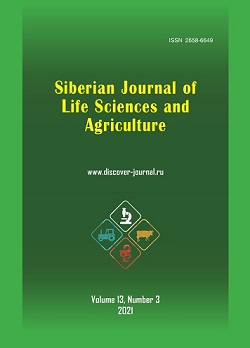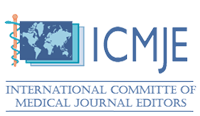МОРФОМЕТРИЧЕСКИЙ АНАЛИЗ ПРИМЕНИМОСТИ УРАВНЕНИЙ MURRAY C.D. ДЛЯ ЧИСЛЕННОГО МОДЕЛИРОВАНИЯ СОСУДИСТЫХ ДИХОТОМИЙ ПОЧКИ ЧЕЛОВЕКА
Аннотация
Цель. Провести анализ применимости уравнений Murray C. D. для расчёта значений углов дихотомий внутриорганного артериального и венозного русел почки человека.
Материал и методы. Были исследованы внутриорганные артерии и вены почек. Почки полученны на аутопсии у людей (возраст от 36 до 74 лет; 9 человек мужского пола, 8 – женского), изготовлены 17 коррозионных препаратов: 9 препаратов артериальное русло, 8 – венозное. Визуализацию проводили с помощь микротомографа BRUNKER SkyScan 1178. Для морфометрии использовали программный пакет blender с надстройкой NeuroMorph Measuring tools. Измеряли диаметры сегментов (D, dmax, dmin) и углы между ними (αmax, αmin). Для расчетов углов дихотомии пользовались уравнениями Murray C. D.
Результаты. Установлено наличие четырех структурно-различных типов дихотомий, составляющих внутриорганное сосудистое русло почки. Показано, что применять уравнение Murray C. D. для расчетов величины угла αmax можно для любых структурно-различных типов сосудистых дихотомий почки человека. Однако использовать уравнение Murray C. D. для расчетов значений угла αmin нельзя для артериальных и венозных дихотомий 1-го структурно-различного типа и для 2-го типа венозных дихотомий.
Заключение. Применение уравнений Murray C. D. для численного моделирования сосудистых дихотомий почки человека носит ограниченный характер. Это необходимо учитывать при создании структурных математических моделей сосудистого русла почки человека.
Скачивания
Литература
Avtandilov G.G. Meditsinskaya morfometriya. Rukovodstvo [Medical morphometry. Tutorial]. M.: Meditsina, 1990, 384 p.
Glotov V.A. Strukturnyy analiz mikrososudistykh bifurkatsiy (mikrososudistyy uzel i gemodinamicheskiy faktor) [Structural analysis of the microvascular bifurcations (microvascular node and hemodynamic factor]. Smolensk: Ampipress, 1995, 251 p.
Zenin O.K., Beshulya O.A. Morfometricheskiy analiz dikhotomiy vnutriorgannogo arterial’’nogo rusla pochki [Morphologycal analysis f dichotomies of the kidney intraorganic arterial bed]. Izvestiya vysshikh uchebnykh zavedeniy. Povolzhskiy region [University proceedings. Volga region], 2013, no. 4 (28), pp. 26-34.
Mamisashvili V.A., Babunashvili M.K. Kriteriy optimal’nogo funktsionirovaniya podsistem krupnykh i melkikh pial’nykh arteriy [Optimal functioning of the subsystems of large and small pial arteries criteria]. Fiziologicheskiy zhurnal SSSR [USSR Physiological jornal], 1975, vol. 61, no. 10, pp. 1501-1506.
Lyakh Yu.E. et al. Osnovy komp’yuternoy biostatistiki: analiz informatsii v biologii, meditsine i farmatsii statisticheskim paketom MedStat [Computer biostatistics basics: data analysis in biology, medicine and pharmacology with MedStat app]. Donetsk: Papakitsa E. K., 2006. 214 p.
Kafarov E. S. Dmitriev A.V., Zenin O.K., Vezirkhanov A.Z., Vagabov I.U., Miltykh I.S. Polimernaya rentgenkontrastnaya smes’’ dlya izgotovleniya korrozionnykh anatomicheskikh preparatov [Polymer radiopaque mixture for the manufacture of corrosive anatomical preparations]: pat. 145561 Ukraine: MPK A01N 1/02; applied. 09.06.2020; published. 28.12.2020, Byul. № 24. 6 p.
Rozen R. Printsip optimal’nosti v biologii [Optimality principle in biology]. M.: Mir, 1969. 231 p.
Kіryakulov G.S., Zenіn O.K., Khadzhinov D.G., Neudachina K.A., Balabanova Yu.V. Sposіb vigotovlennya korozіynikh preparatіv sudinnoї sistemi porozhnistogo organa [A method of manufacturing corrosion preparations of the vascular system of the hollow organ]: pat. 42409A Ukraine, MPK 7A61F2/06. / № 2001021136; applied. 19.02.2001; published. 15.10.2001, Byul. № 9. 2 p.
Janssen, C.R.M., C.L. de Korte, M.S. van der Heiden, C.P.A. Wapenaar, and A.F.W. van der Steen. Angle Matching in Intravascular Elastography. Ultrasonics, 2000, vol. 38, no. 1–8, pp. 417–423. https://doi.org/10.1016/s0041-624x(99)00188-2
Beek J.H.G.M. Van S.A. Roger, Bassingthwaighte J.B. Regional Myocardial Flow Heterogeneity Explained with Fractal Networks. American Journal of Physiology-Heart and Circulatory Physiology, 1989, vol. 257, no. 5, pp. H1670-H1680. https://doi.org/10.1152/ajpheart.1989.257.5.h1670
Bell, John B, Phillip Colella, Harland M Glaz. A Second-Order Projection Method for the Incompressible Navier-Stokes Equations. Journal of Computational Physics, 1989, vol. 85, no. 2, pp. 257–283. https://doi.org/10.1016/0021-9991(89)90151-4
Moccia, Sara, Elena De Momi, Sara El Hadji, Leonardo S. Mattos. Blood Vessel Segmentation Algorithms – Review of Methods, Datasets and Evaluation Metrics. Computer Methods and Programs in Biomedicine, 2018, vol. 158, pp. 71–91. https://doi.org/10.1016/j.cmpb.2018.02.001
Cavagna, Giovanni. Circulation of Blood. Fundamentals of Human Physiology. Springer International Publishing, 2019. pp. 1–63. https://doi.org/10.1007/978-3-030-19404-8_1
European Convention for the Protection of Vertebrate Animals Used for Experimental and Other Scientific Purposes. Strasbourg, 1986.
Revellin, Rémi, François Rousset, David Baud, Jocelyn Bonjour. Extension of Murray’s Law Using a Non-Newtonian Model of Blood Flow. Theoretical Biology and Medical Modelling, 2009, vol. 6, no. 1, Article number: 7. https://doi.org/10.1186/1742-4682-6-7
Kretowski, Marek, Yan Rolland, Johanne Bézy-Wendling, Jean-Louis Louis Coatrieux. Fast Algorithm for 3-D Vascular Tree Modeling. Computer Methods and Programs in Biomedicine, 2003 vol. 70, no. 2, pp. 129–36. https://doi.org/10.1016/s0169-2607(01)00200-0
Fredrich, Thierry, Michael Welter, Heiko Rieger. Dynamic Vessel Adaptation in Synthetic Arteriovenous Networks. Journal of Theoretical Biology, 2019, vol. 483, 109989. https://doi.org/10.1016/j.jtbi.2019.109989
Green, Samuel B, Neil J Salkind. Using SPSS for Windows and Macintosh: Analyzing and Understanding Data. 6th ed. Englewood Cliffs, NJ: Prentice-Hall, 2012.
Greenwald S.E., Berry C.L. Improving Vascular Grafts: The Importance of Mechanical and Haemodynamic Properties. The Journal of Pathology, 2000, vol. 190, no. 3, pp. 292–299. https://doi.org/10.1002/(SICI)1096-9896(200002)190:3<292::AID-PATH528>3.0.CO;2-S
Hagmeijer R., Venner C.H. Critical Review of Murray’s Theory for Optimal Branching in Fluidic Networks. ArXiv, December 23, 2018. http://arxiv.org/abs/1812.09706
LaBarbera M. Principles of Design of Fluid Transport Systems in Zoology. Science, 1990, vol. 249, no. 4972, pp. 992–1000. https://doi.org/10.1126/science.2396104
Leuprecht Armin, Perktold Karl. Computer Simulation of Non-Newtonian Effects on Blood Flow in Large Arteries. Computer Methods in Biomechanics and Biomedical Engineering, 2001, vol. 4, no. 2, pp. 149–63. https://doi.org/10.1080/10255840008908002
Schreiner, Wolfgang, Friederike Neumann, Martin Neumann, Rudolf Karch, Adelheid End, Susanne M. Roedler. Limited Bifurcation Asymmetry in Coronary Arterial Tree Models Generated by Constrained Constructive Optimization. Journal of General Physiology, 1997, vol. 109, no. 2, pp. 129–40. https://doi.org/10.1085/jgp.109.2.129
Huang, W., R. T. Yen, M. McLaurine, G. Bledsoe. Morphometry of the Human Pulmonary Vasculature. Journal of Applied Physiology, 1996, vol. 81, no. 5, pp. 2123–2133. https://doi.org/10.1152/jappl.1996.81.5.2123
Murray C.D. The Physiological Principle of Minimum Work Applied to the Angle of Branching of Arteries. Journal of General Physiology, 1926, vol. 9, no. 6, pp. 835–41. https://doi.org/10.1085/jgp.9.6.835
Jorstad, Anne, Biagio Nigro, Corrado Cali, Marta Wawrzyniak, Pascal Fua, Graham Knott. NeuroMorph: A Toolset for the Morphometric Analysis and Visualization of 3D Models Derived from Electron Microscopy Image Stacks. Neuroinformatics, 2015, vol. 13, no. 1, pp. 83–92. https://doi.org/10.1007/s12021-014-9242-5
Olufsen, Mette S. A One-Dimensional Fluid Dynamic Model of the Systemic Arteries. Studies in Health Technology and Informatics, 2000, vol. 71, pp. 79–97. https://doi.org/10.3233/978-1-60750-915-8-79
Vasilevski, Yuri, Maxim Olshanskii, Sergey Simakov, Andrey Kolobov, and Alexander Danilov. Personalized Computational Hemodynamics. Personalized Computational Hemodynamics. Elsevier, 2020. https://doi.org/10.1016/C2017-0-02421-7
Pollanen, M.S. “Dimensional Optimization at Different Levels of the Arterial Hierarchy.” Journal of Theoretical Biology 159, no. 2 (1992): 267–70. https://doi.org/10.1016/S0022-5193(05)80706-4
Pries, Axel R., Timothy W. Secomb, Peter Gaehtgens. Design Principles of Vascular Beds. Circulation Research, 1995, vol. 77, no. 5, pp. 1017–23. https://doi.org/10.1161/01.RES.77.5.1017
Martinez-Perez, M. Elena, Alun D. Hughes, Alice V. Stanton, Simon A. Thom, Neil Chapman, Anil A. Bharath, Kim H. Parker. Retinal Vascular Tree Morphology: A Semi-Automatic Quantification. IEEE Transactions on Biomedical Engineering, 2002, vol. 49, no. 8, pp. 912–917. https://doi.org/10.1109/TBME.2002.800789
Roux W. Ueber Die Verzweigungen Der Blutgefsse. Eine Morphologische Studie. Z. Naturwissenschaft, 1878, vol. 12, pp. 205–66.
Standring, Susan. Gray’s Anatomy E-Book: The Anatomical Basis of Clinical Practice. 42nd ed. London: Elsevier Health Sciences, 2021.
Schreiner, Wolfgang, M Neumann, Friederike Neumann, Susanne M. Roedler, Adelheid End, P. Buxbaum, Mrcael R. Müller, Paul Spieckermann. The Branching Angles in Computer-Generated Optimized Models of Arterial Trees. Journal of General Physiology, 1994, vol. 103, no. 6, pp. 975–989. https://doi.org/10.1085/jgp.103.6.975
Uylings H. B. M. Optimization of Diameters and Bifurcation Angles in Lung and Vascular Tree Structures. Bulletin of Mathematical Biology, 1977, vol. 39, no. 5, pp. 509–520. https://doi.org/10.1007/BF02461198
Zamir, M., D. C. Bigelow. Cost of Departure from Optimality in Arterial Branching. Journal of Theoretical Biology, 1984, vol. 109, no. 3, pp. 401–409. https://doi.org/10.1016/S0022-5193(84)80089-2
Zamir M., H. Chee. Branching Characteristics of Human Coronary Arteries. Canadian Journal of Physiology and Pharmacology, 1986, vol. 64, no. 6, pp. 661–668. https://doi.org/10.1139/y86-109
Просмотров аннотации: 343 Загрузок PDF: 305
Copyright (c) 2021 Oleg K. Zenin, Ilia S. Miltykh, Andrey V. Dmitriev, Olga O. Iurchenko

Это произведение доступно по лицензии Creative Commons «Attribution-NonCommercial-NoDerivatives» («Атрибуция — Некоммерческое использование — Без производных произведений») 4.0 Всемирная.






















































